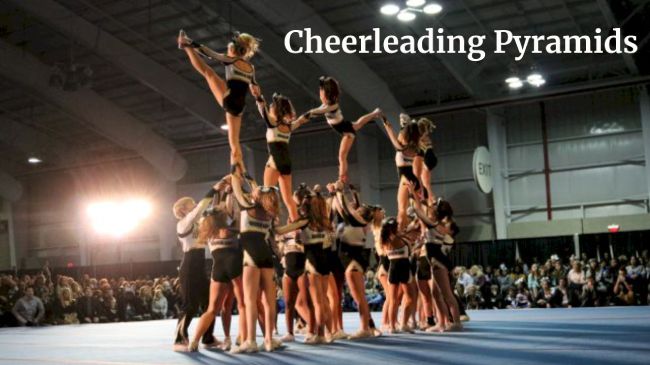A cheerleading pyramid requires skilled stunting, trust among teammates, and a keen awareness of safety.
Cheerleading Pyramid Terms
A cheerleading pyramid is essentially one big stunt train. When lifts, poses, and dismounts are combined creatively, you end up with a visually impressive stunt. Everyone on the squad needs to be on the same page. If you are teaching cheerleading pyramids to your squad for the first time, it is important to begin with the right vocabulary.
- The flyer is at the top of the pyramid. It is because she will “fly” back down to safety that she is known as the flyer.
- The base is the person at the bottom of the pyramid.
- A pyramid with one-and-a-half levels is equal to the height of one person plus half the height of another.
- A two-person pyramid is the height of two people.
- Approximately the height of two and a half people: The pyramid is approximately the height of two and a half people. Certain squads are prohibited from using these pyramids in cheerleading competitions. The top tier flyer also requires an additional spotter in the front and back.

How to Build a Pyramid
Pyramids can be divided into several parts:
- All the cheerleaders get into position during the transition or set up.
- Loading: This refers to how you get the flyer onto the page.
- You hit a pyramid when you strike your final pose so your audience can see it.
- As soon as the flyer jumps off the pyramid and lands safely, she dismounts.
As you begin working on a new pyramid, it’s important to go slowly and take your time to make sure everyone understands what they are doing. Priority should be given to safety above all else. The best cheerleading pyramids can be built by following this step-by-step guide.
Setting It Up
Have you ever gone through an entire stunt sequence, describing every move and transition in detail, only to have your squad stare blankly back at you? In order to execute a great cheerleading pyramid, you must first determine what the final product will look like.
The first thing you should do is arrange your flyers on the floor. Spotters can be used if necessary. However, you don’t want to put your flyers up in the air until you see how the pyramid looks.
Additionally, this will allow them to become comfortable with the body position needed to “hit” the pyramid. Draw a picture if that doesn’t work.
Partner Stunting
Without solid stunting skills, you are sure to miss your pyramid. Spend some time ensuring your flyers can execute their stunts on cue before you attempt to link a pyramid together. This step might seem tedious at times, but it is an essential safety precaution. T
he mid-bases of your pyramid need to have complete confidence in their body positions and what they’re doing before loading the top flyer.
Dismounts
It is essential that everyone in the pyramid understands how the flyer will dismount. Spotters should be aware of their positions and role during the dismount. In order to execute her dismount successfully, the flyer must be confident. Breaking down the pyramid into sections and practicing the appropriate dismounting can ensure that everyone knows what to do.
Five Steps To a Cheerleading Pyramid
The first step. The pyramid can be broken up into sections or sides. The sides should be built one at a time before putting them together. You should use extra spotters and catchers the first time. 2. The mid-bases should be loaded. Make sure they are stable and solid.
There are three. Make sure the top flyers are loaded.
The fourth point. The flyer should be loaded again if the mid-bases are still there after the flyer comes down. To avoid fatiguing the bases, take a break if the flyer is still unable to hit it.
There are five. Have the top flyer dismount first once she gets in position. After that, the mid-bases should dismount.
When everyone has hit all their positions, putting it together should be a breeze!
Popular Pyramid Stunts
A variety of pyramids are formed by cheerleaders.
- Simple Pyramid: Junior All Stars practicing pyramids. As you watch the video, you’ll notice how alternating the timing between the different sides of the pyramids creates more visual appeal and makes the stunt seem more difficult than it is.
- The inside hitch is named as such because the foot on the thigh of the middle flyer is on the inside. At the end, note the dismount from the cradle.
- Note how this wolf wall seems to go up in one fluid motion. As a team, you should always work together as if you were an extension of each other.
